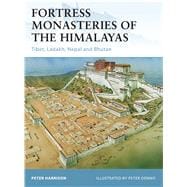
What is included with this book?
| Introduction | p. 4 |
| Chronology | p. 5 |
| Tibetan Culture and its Distinctive Architecture | p. 6 |
| The development of the Tibetan Cultural Region | |
| A brief outline of a distinctive architecture | |
| The Causes and Nature of Warfare in the Tibetan Cultural Region | p. 10 |
| Religious conflicts, civil wars and invasions | |
| The raising of standing forces and militias | |
| Equipment of the armed forces and militias | |
| Training and the method of warfare | |
| Himalayan Fortifications | p. 13 |
| Generic approaches and the principles of defence | |
| The Fortified Monasteries of Tibet | p. 16 |
| The background | |
| The architectural features of the fortress monasteries, exemplified by the southern monastery at Sakya | |
| Chokorgyel Monastery: the Triune, 'three in one', gompa | |
| Gyantse - dzongs, monasteries and the British | |
| The Potala: the holy palace in the snow land | |
| The Fortress Monasteries and Monastic Palace Fortresses of Ladakh | p. 30 |
| The Namgyal Dynasty | |
| The fortress monasteries of the 17th century | |
| The defensive system in the Ladakhi Indus Valley | |
| The hidden valleys of Zanskar, Lahaul and Spiti | |
| Nepal | p. 38 |
| The hidden Kingdom of Mustang and the fortified town of Lo Manthang | |
| The other monasteries of Mustang | |
| The Dzongs of Bhutan | p. 41 |
| The Shabdrung and the heavenly abodes of the tantric divinities | |
| The characteristics of Bhutanese dzongs | |
| Aftermath | p. 49 |
| Destruction, neglect and changing circumstances | |
| Tibet | |
| Ladakh and the 'hidden valleys' | |
| Mustang, Nepal | |
| Bhutan | |
| The Sites Today | p. 57 |
| Tibet | |
| Ladakh | |
| Mustang | |
| The fortress monasteries of Bhutan | |
| Further Reading | p. 61 |
| Glossary | p. 62 |
| Index | p. 64 |
| Table of Contents provided by Ingram. All Rights Reserved. |
The New copy of this book will include any supplemental materials advertised. Please check the title of the book to determine if it should include any access cards, study guides, lab manuals, CDs, etc.
The Used, Rental and eBook copies of this book are not guaranteed to include any supplemental materials. Typically, only the book itself is included. This is true even if the title states it includes any access cards, study guides, lab manuals, CDs, etc.